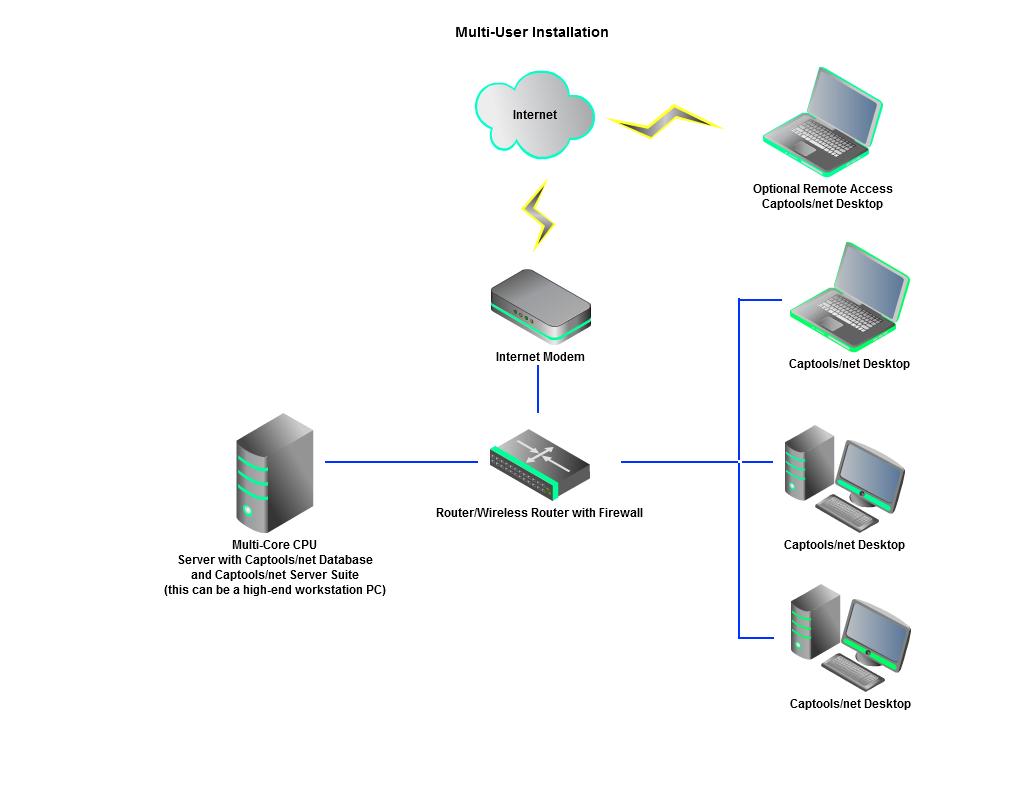Software whose data is designed to be able to be accessed simultaneously by multiple users, must employ a more complex system architecture. In these systems, the data typically resides upon one computer called a server and is accessed by users from other computers running software called client software, which for our product we call "Captools/net Desktop". This arrangement is used by multi-user versions of Captools/net, and can be depicted as follows for a typical office setup:

In this example, the Database and Captools/net Server-side applications are shown as residing on a multi-core Server computer. The Database actually consists of the files which contain the actual data, and the software that processes the SQL commands operate on that data, including fetching and updating data. The Captools/net server-side software consists of a number of programs which request data from the database software and pass that data on to the client computer, or which perform computations on the data to either generate output such as reports, or which gather data from external sources such as custodian data files or web downloads to populate the database.
The availability Multi-core and multi-CPU Servers now facilitates system scaling to many users often without the need to add multiple servers or a separate database server. For "small offices" Captools/net does not require a "Server-Grade" machine (i.e. with ECC memory, RAID Drives, or even the MS-Windows Server OS). In many such cases a good performance high end work station can comfortably handle up to 3 or 4 users, and scheduled daily backups to a second drive can protect against data loss. If out-of-office Remote Access is desired, you will typically need a fixed IP address and associated internet modem configuration to permit access from outside the local area network. This communication is secured by using SSL and HTTPS protocols.
For larger offices, a server running MS-Windows Server (e.g. Server 2008/higher) and using ECC memory is recommended. Such a machine typically should be able to be scaled by adding multi-core CPU's and RAM memory to support addition of users and client accounts. In both the small and larger office scenarios, it is preferred that the server be dedicated primarily for Captools/net use so as to minimize resource conflicts with other applications.
Captools/net is normally installed on the Server machine with MS-SQL Server Express, which is the base level SQL Server product from Microsoft. This is often adequate for users with up to several hundred accounts under management. Users with a larger amount of data will find it advantageous to obtain a higher level "paid" licensed version of MS-SQL Server so as to not be subject to the memory utilization constraints imposed by the MS-SQL Server Express version.
The Captools/net Desktop software provides an end user with a view into their data and gives them an opportunity to edit and filter data with an editing friendly interface. However, it performs very little in the way of computations or other functions. These are performed on the server computer.
Many of the important data-handling and computational tasks can be triggered on an automatic basis, (e.g. data downloads, scheduled valuations, etc.) or can be triggered by a designated user. Many of these tasks can be administered remotely through browser-based interfaces, as can the reporting process.